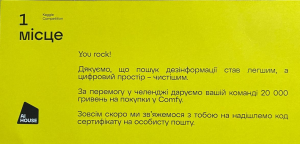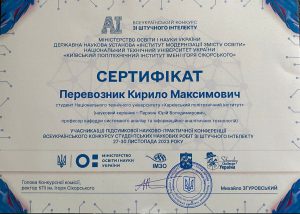Abstract of the Direction
Founder and head of the direction – Doctor of Technical Sciences, Professor Yuriy Volodymyrovych Parzhin
Modern artificial neural network (ANN) models are built on the connectionist principle (connectionist paradigm), which involves storing data in the form of neuron weight coefficients and adjusting these coefficients during training. This approach stems from the use of the McCulloch-Pitts model as the primary artificial neuron model, which, given the current state of neuroscience, is not biologically plausible. It also relies on the concept of ANN design proposed by F. Rosenblatt, which is similarly not biologically justified. The need to train deep connectionist ANNs led to the development of the backpropagation algorithm, which clearly shows that modern ANN development is taking a different path from building biologically inspired models. Today’s approach to ANN development allows for the construction of universal input-type approximators and classifiers, which, however, are designed only for specific tasks and require large datasets due to their statistical nature of training. This necessitates complex ANN models and demands significant time and computational resources. Furthermore, issues arise regarding the retraining of these models and trust in their outcomes, especially with the use of generative models.
Therefore, there is a scientific and technical challenge to develop new neuron models that are more biologically adequate and to construct ANN models and training methods based on them. Solving this problem may help overcome existing limitations of connectionist ANNs and lay the foundation for the development of Artificial General Intelligence (AGI).
Object of Research is the process of solving intelligent tasks using artificial neural networks.
Subject of Research is the principles of construction and training of structurally-detector artificial neural networks.
Purpose of the Research is to improve the efficiency of solving image classification and clustering tasks based on the use of models, methods, and algorithms for building and training structurally-detector artificial neural networks (SDANN).
To achieve the stated goal, the following tasks must be completed: analyze the current state of research and development in the field of artificial neural network construction and training, develop a biologically justified model of a detector neuron, design and study a training algorithm for the detector neuron, develop the architecture of a structurally-detector neural network (SDANN), create and evaluate a direct training algorithm for SDANN, solve classification and clustering tasks using SDANN, develop a software model for constructing the SDANN architecture for contour-based 2D image recognition, develop a software model for the SDANN training algorithm for 2D contour image recognition, and evaluate the effectiveness of SDANN in solving classification and clustering tasks.
OBTAINED RESULTS
Publications
- Parzhin Y. Hypotheses of neural code and the information model of the neuron-detector. Journal: ScienceOpen Research – Section: SOR-COMPSCI DOI: 10.14293/S2199-1006.1.SOR-COMPSCI.AP5TO7.v1, 2014. 38с.
- Parzhin Y.V. The Detector Principle of Artificial Neural Networks Construction as an Alternative to the Connectionist Paradigm. Control, Navigation and Communication Systems. Collection of Scientific Papers. Yuri Kondratyuk Poltava National Technical University, Issue 4(44), 2017, pp. 80–101.
- Parzhin Y., Rohovyi A., Nevliudova V. Detector artificial neural network. Neurobiological rationale. Information systems and innovative technologies in project and program management. Collective monograph edited by L. Linde, I. Chumachenko, V. Timofeyev. ISMA University of Applied Science. Riga (Latvia). 2019. – 349 p. (PP. 331-339).
- Parzhin Y.V., Soloshchuk M.N., Liubchenko N.Yu. Information Analysis in Neuromorphic Information Models of Neurons. Bulletin of the National Technical University “KhPI”. Series: System Analysis, Control and Information Technologies, No. 2, 2019, Kharkiv: NTU “KhPI”, pp. 55–62.
- Parzhin Y., Kosenko V., Podorozhniak A., Malyeyeva O., Timofeyev V. Detector neural network vs connectionist ANNs. Elsevier, Neurocomputing Vol. 414 (2020), 13 November 2020, p. 191–203, https://doi.org/10.1016/j.neucom.2020.07.025.
- Parzhin Y., Galkyn S., Sobol M. Method For Binary Contour Images Vectorization Of Handwritten Characters For Recognition By Detector Neural Networks. Conference proceedings 2022 IEEE khpi Week Kharkiv, Ukraine, October 03 – 07. P 167- 172.
- Bokhan, K., Degtyarenko, I., Radyvonenko, O., Khomenko, V. Text/shape classifier for mobile applications with handwriting input. International Journal on Document Analysis and Recognitionthis, 2016, 19(4), pp. 369–379.
- Bokhan, K., Khomenko, V., Shyshkov, O., Radyvonenko, O. Accelerating recurrent neural network training using sequence bucketing and multi-GPU data parallelization. Proceedings of the 2016 IEEE 1st International Conference on Data Stream Mining and Processing, DSMP 2016, 2016, pp. 100–103.
- Bokhan, K., Kurochkin, A. Generation of memes to engage audience in social media. CEUR Workshop Proceedingsthis link is disabled, 2020, 2566, pp. 10–20.
- Liubchenko Natalia, Podorozhniak Andrii, Balenko Oleksii, Zhuikov Dmytro. Neural network approach for multispectral image processing. 14th International Conference on Advanced Trends in Radioelecrtronics, Telecommunications and Computer Engineering (TCSET 2018). 2018., pp. 978-981.
- Liubchenko N, Podorozhniak A., Bondarchuk V. Neural network method of intellectual processing of multispectral images. Advanced Information Systems. Issue 1 (#2), 2017, pp. 39-44.
- Liubchenko N., Podorozhniak A., Onishchenko D. NDVI-Based Vegetation Change Detection Using Neural Networks. Informatics, Control, and Artificial Intelligence: Proceedings of the 10th International Scientific and Technical Conference, Kharkiv–Kramatorsk–Ternopil, May 10–12, 2023. Kharkiv: Impress, 2023, p. 77.
- Liubchenko, N., Podorozhniak, A., Onishchenko, D. Development of forestry application using deep learning technology. 2022 International Conference on Innovative Solutions in Software Engineering (ICISSE). pp. – 216.
Scientific Clubs
In this scientific direction , the student scientific club “Штучний інтелект та машинне навчання“, operates at the department, with Professor Yu.V. Parzhyn as the scientific supervisor.
One of the achievements of this club is the victory of student Kyrylo Maksymovych Perevoznyk (group KН-М323) at the All-Ukrainian Student Research Paper Competition in Artificial Intelligence in 2023 (3rd place), as well as his victory in 2023 at the Kaggle Competition by AI-House in the field of misinformation detection, as part of a team of students from various higher education institutions of Ukraine.


